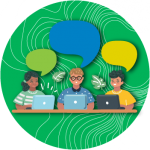
Imagine this: your child is getting older and thinks picture books are for babies. The “reader” books are too easy and provide little challenge. But when your child looks at the books on the shelves for chapter books, they become overwhelmed. There are too many choices!
The transition from reading picture books and reader books to chapter books can be a tricky one for young readers.
There are many stumbling blocks for kids to overcome when making the transition:
- Number of pages—the number of pages in one of the “reader” books is usually 30 or less. Chapter books for children can range from 70 pages to 500! That is a significant difference.
- Amount of text—the actual print in chapter books is smaller than in the readers, sometimes much smaller. When a transitioning reader opens a chapter book to see big blocks of small print, it can be quite daunting.
- Few illustrations—picture books, of course, have many illustrations. Reader books are also visually focused. Chapter books either have very few or no illustrations at all. Pictures provide clues to young readers as to what is happening in a story. Readers who pick up chapter books no longer have the help of pictures and must now rely entirely on their understanding of the words.
- Time—pictures books and reader books can be read in one sitting. A young reader has a feeling of accomplishment when finishing a book. Chapter books cannot be read in one sitting.
There are ways in which to ease the transition
- Prepare—when browsing for chapter books, look at the covers and flip through the pages. It should not take long to rule out certain books. Transitioning from a 30-page reader book to a 500-page chapter book with small print is much too big a jump. Most kids can recognize this immediately. They will return the book to the shelves quickly with a firm ‘no.’
- Find the “just-right” book—just like Goldilocks and the Three Bears, young readers need to find chapter books that are not too long and not too short!
Another important factor in finding the “just-right” chapter books are the themes, characters, and stories
If your child likes mysteries, then try a mystery chapter book. If your child likes dogs, find a book that features dogs either as the main character or as a pet for the main character. Even finding characters that look like your child or have similar family situations can be a great way to get a child into reading longer books.
- Find a series—if you can find a series of chapter books, then that will keep your child reading book after book. It’s a great way to continue the positive reading experience. If they like the first book, then it’s natural to want to keep going. Some chapter book series have dozens of books!
- Graphic novels—graphic novels are a great way to transition to longer chapter books. They often have more complicated storylines than early readers and they also contain visuals, which kids will appreciate.
- Novels in verse—these are novels written in verse, like a poem. Because they are in verse, there is a lot of white space on the pages and fewer words. White space on a page appeals to kids transitioning to chapter books. The cadence of these novels are more lyrical which often makes them easier to read than books written in prose.
- “Diaries”—there are many books written like diaries that are very popular with kids. These are great books for kids who are not confident enough to jump into difficult chapter books but are ready for something a little more challenging. These diary-type books are written in a conversational tone that is easy to read, and they also contain fun drawings.
- Use a strategy—in our blog series about reading strategies, we explain several different strategies to use to aid in reading. All of these, from Asking Questions to Making Predictions will help a child who is new to reading chapter books. The strategies can be even more helpful with chapter books since these books have more involved storylines and complicated characters.
One thing to look out for
Some young readers struggle in a way that may appear good at first, but can be harmful in the long run. These readers are overconfident and choose books that are much too difficult. The problem with this is they will get frustrated when they can’t read the chosen book with enough fluency. This can lead to a mistaken belief that they “can’t read.” If there is question about whether a book is appropriate for reading level, do an easy test. Have your child read about 50 words on a page out loud, which may be about half the page. If they miss 5 words or more, that book is most likely too difficult. Try a different book.
One thing to remember above all
Keep trying! If your child picks a book they don’t like, try again. There is always that one book or series that jump-starts a child’s chapter book reading. It’s a wonderful feeling when that happens and it will carry them onto more challenging reading in the future.
Here are some tried-and-true favorite chapter books and series from our Reading Help program!
Junie B. Jones and the Stupid Smelly Bus
Tales From A Not-so-fabulous Life
 Visit Learn at Home for even more great resources, including:
Visit Learn at Home for even more great resources, including:
- Free online tutoring
- Online tools available 24x7x365
- Recommended items from our collection that you can pick up curbside

